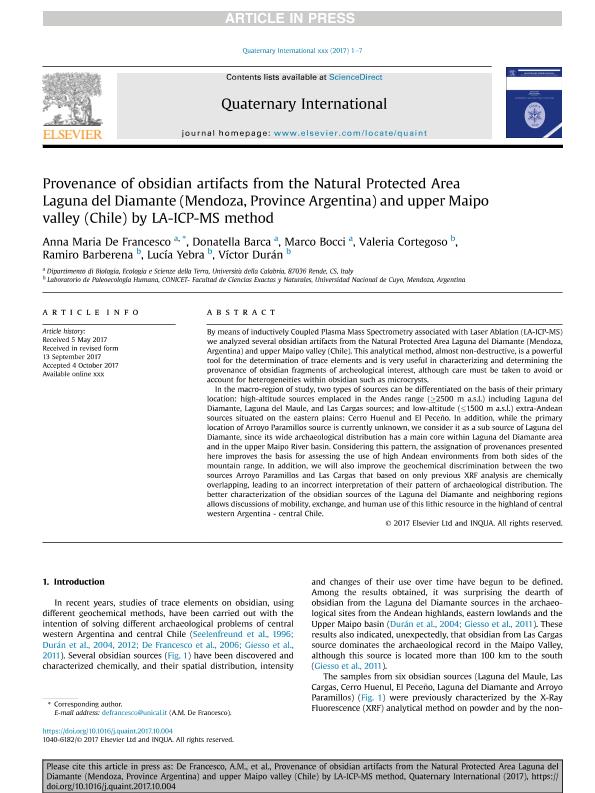Mostrar el registro sencillo del ítem
dc.contributor.author
De Francesco, Anna Maria
dc.contributor.author
Barca, Donatella
dc.contributor.author
Bocci, Marco
dc.contributor.author
Cortegoso, Valeria

dc.contributor.author
Barberena, Ramiro

dc.contributor.author
Yebra, Lucía Gabriela

dc.contributor.author
Duran, Victor Alberto

dc.date.available
2018-04-18T14:10:41Z
dc.date.issued
2017-11
dc.identifier.citation
De Francesco, Anna Maria; Barca, Donatella; Bocci, Marco; Cortegoso, Valeria; Barberena, Ramiro; et al.; Provenance of obsidian artifacts from the Natural Protected Area Laguna del Diamante (Mendoza, Province Argentina) and upper Maipo valley (Chile) by LA-ICP-MS method; Pergamon-Elsevier Science Ltd; Quaternary International; 468; Part A; 11-2017; 134-140
dc.identifier.issn
1040-6182
dc.identifier.uri
http://hdl.handle.net/11336/42433
dc.description.abstract
By means of inductively Coupled Plasma Mass Spectrometry associated with Laser Ablation (LA-ICP-MS)we analyzed several obsidian artifacts from the Natural Protected Area Laguna del Diamante (Mendoza,Argentina) and upper Maipo valley (Chile). This analytical method, almost non-destructive, is a powerfultool for the determination of trace elements and is very useful in characterizing and determining the provenance of obsidian fragments of archeological interest, although care must be taken to avoid oraccount for heterogeneities within obsidian such as microcrysts.In the macro-region of study, two types of sources can be differentiated on the basis of their primary location: high-altitude sources emplaced in the Andes range (2500 m a.s.l.) including Laguna del Diamante, Laguna del Maule, and Las Cargas sources; and low-altitude (1500 m a.s.l.) extra-Andean sources situated on the eastern plains: Cerro Huenul and El Pece~no. In addition, while the primary location of Arroyo Paramillos source is currently unknown, we consider it as a sub source of Laguna del Diamante, since its wide archaeological distribution has a main core within Laguna del Diamante area and in the upper Maipo River basin. Considering this pattern, the assignation of provenances presented here improves the basis for assessing the use of high Andean environments from both sides of the mountain range. In addition, we will also improve the geochemical discrimination between the two sources Arroyo Paramillos and Las Cargas that based on only previous XRF analysis are chemicallyoverlapping, leading to an incorrect interpretation of their pattern of archaeological distribution. The better characterization of the obsidian sources of the Laguna del Diamante and neighboring regions allows discussions of mobility, exchange, and human use of this lithic resource in the highland of central western Argentina - central Chile.
dc.format
application/pdf
dc.language.iso
eng
dc.publisher
Pergamon-Elsevier Science Ltd

dc.rights
info:eu-repo/semantics/openAccess
dc.rights.uri
https://creativecommons.org/licenses/by-nc-sa/2.5/ar/
dc.subject
Obsidian Geochemistry
dc.subject
Provenance
dc.subject
La-Icp-Ms Method
dc.subject
Andes Cordillera
dc.subject.classification
Historia

dc.subject.classification
Historia y Arqueología

dc.subject.classification
HUMANIDADES

dc.title
Provenance of obsidian artifacts from the Natural Protected Area Laguna del Diamante (Mendoza, Province Argentina) and upper Maipo valley (Chile) by LA-ICP-MS method
dc.type
info:eu-repo/semantics/article
dc.type
info:ar-repo/semantics/artículo
dc.type
info:eu-repo/semantics/publishedVersion
dc.date.updated
2018-04-16T13:46:54Z
dc.journal.volume
468
dc.journal.number
Part A
dc.journal.pagination
134-140
dc.journal.pais
Estados Unidos

dc.journal.ciudad
San Diego
dc.description.fil
Fil: De Francesco, Anna Maria. Universidad de la Calabria; Italia
dc.description.fil
Fil: Barca, Donatella. Universidad de la Calabria; Italia
dc.description.fil
Fil: Bocci, Marco. Universidad de la Calabria; Italia
dc.description.fil
Fil: Cortegoso, Valeria. Consejo Nacional de Investigaciones Científicas y Técnicas; Argentina. Universidad Nacional de Cuyo. Facultad de Ciencias Exactas y Naturales; Argentina
dc.description.fil
Fil: Barberena, Ramiro. Consejo Nacional de Investigaciones Científicas y Técnicas; Argentina. Universidad Nacional de Cuyo. Facultad de Ciencias Exactas y Naturales; Argentina
dc.description.fil
Fil: Yebra, Lucía Gabriela. Consejo Nacional de Investigaciones Científicas y Técnicas; Argentina. Universidad Nacional de Cuyo. Facultad de Ciencias Exactas y Naturales; Argentina
dc.description.fil
Fil: Duran, Victor Alberto. Consejo Nacional de Investigaciones Científicas y Técnicas; Argentina. Universidad Nacional de Cuyo. Facultad de Ciencias Exactas y Naturales; Argentina
dc.journal.title
Quaternary International

dc.relation.alternativeid
info:eu-repo/semantics/altIdentifier/doi/http://dx.doi.org/10.1016/j.quaint.2017.10.004
dc.relation.alternativeid
info:eu-repo/semantics/altIdentifier/url/https://www.sciencedirect.com/science/article/pii/S1040618217306821
Archivos asociados
